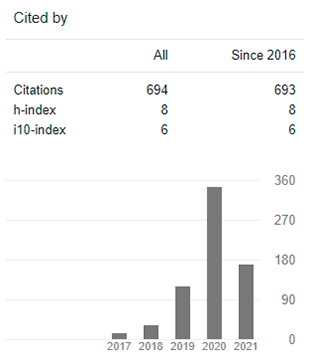Distance education with an intercultural approach in high school students
DOI:
https://doi.org/10.29394/Scientific.issn.2542-2987.2022.7.24.17.325-343Keywords:
intercultural education, long distance education, teaching levelAbstract
This research work intends to report the events that evolved in distance education during the pandemic caused by the SARVS-COV2 virus, and in which there was a need to adapt content towards an intercultural approach, since thanks to the school opening that originated the distance modality, allowed to offer admission to upper secondary level to young people who were in remote geographical points, competing for a space at the national level to belong to the student community of preference. The pandemic showed areas of opportunity where it unified students to work online with government support in order to avoid academic lag and school dropout in Mexico. A proposal is included to integrate students from different cultures through the intercultural approach, this creates belonging and integration in a school community, in addition, teachers must constantly update themselves and be prepared to face both simple problems of a student from their locality and for those from different places, ideologies, types of skills and knowledge. The educational community should be made aware of the need for participation and the influence that the family has on it, integrating didactic strategies that promote interculturality.
Downloads
References
Bernabé, M. (2012). Contextos pluriculturales, educación musical y Educación Intercultural. El Artista, (9), 190-214, e-ISSN: 1794-8614. Recuperado de: https://www.redalyc.org/articulo.oa?id=87424873012
Iriarte, M. (2015). Cultura, Multiculturalidad e Interculturalidad. Análisis de la Educación Intercultural en la Ciudad de Málaga. Tesis. España: Universidad de Málaga.López, R., Hernández, D., & Ortega, J. (coords.). (2021). Educación y contingencia sanitaria por COVID-19. Primera Edición, ISBN: 978-607-502-961-0. México: Biblioteca Digital de Humanidades.
Podestá C. (2006). Un Acercamiento al Concepto de Cultura. Journal of Economics, Finance and Administrative Science, 11(21), e-ISSN: 2077-1886. Recuperado de: https://www.redalyc.org/articulo.oa?id=360733601002
Ramírez, R. (2021). Identifican fallas en Aprende en Casa 2021. México: El Sol de México; Organización Editorial Mexicana.
Salazar, M. (2009). Multiculturalidad e interculturalidad en el ámbito educativo: experiencias de países latinoamericanos. Primera Edición, ISBN: 978-9968-611-30-5. Costa Rica: Editorama S.A. Recuperado de: https://repositorio.iidh.ed.cr/handle/123456789/127
Stenou, K. (2002). Declaración Universal sobre la Diversidad Cultural: una visión, una plataforma conceptual, un semillero de ideas, un paradigma nuevo. ISBN: 9972-841-07-3. París, Francia: UNESCO; UNESDOC Biblioteca Digital.
Saldaña, J. (2020a,b,c). Plan de Continuidad Académica “UAGro en Línea”. Chilpancingo, México: UAGro Virtual; Dirección General de educación Media Superior y Superior; Coordinación de Tecnologías de la Información y Comunicación.
Downloads
Published
How to Cite
Issue
Section
License
Copyright (c) 2022 INDTEC, C.A.

This work is licensed under a Creative Commons Attribution-NonCommercial-ShareAlike 4.0 International License.
The content of the journals of this site, are under a Creative Commons Attribution-Noncommercial-Share Alike 4.0 International License.













